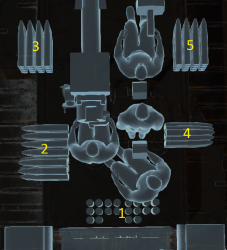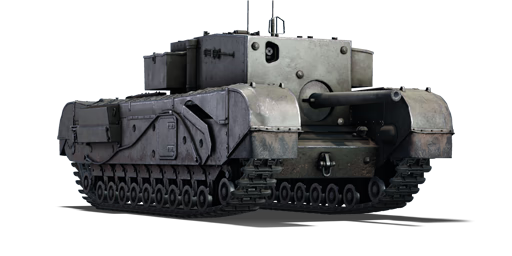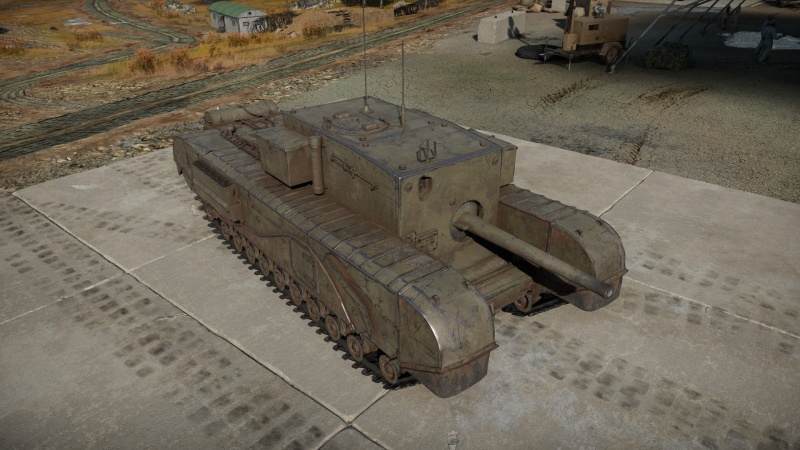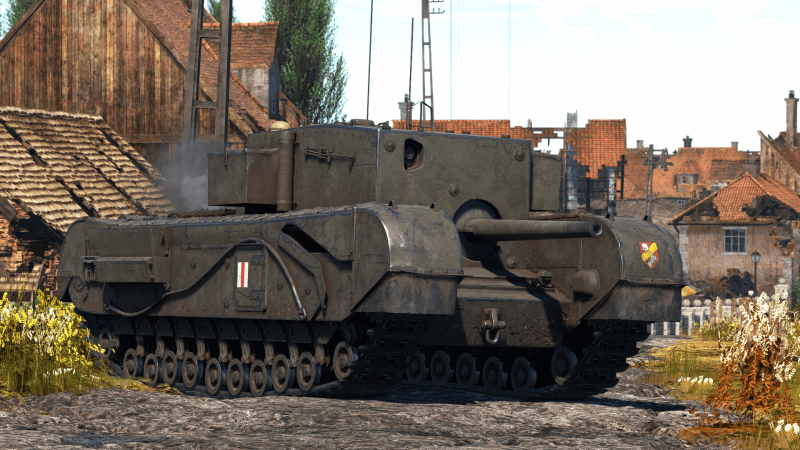Gun Carrier (3-in)
Contents
Description
In 1941, under the possibility of German invasion on British soil, the British Army urgently required modern anti-tank weapons to combat the latest German tanks, particularly mounted as self-propelled guns. The QF 17-pounder was still under development, so as a stop-gap, it was decided to mount the old but proven OQF 3in 20cwt cannon on the chassis of the new Churchill heavy infantry tank. The designers could not install such a gun in any sort of turret (due to its massive breech), so it was decided simply to create a large casemate-type superstructure. The resulting vehicle was named Gun Carrier, 3-inch, Mk I, Churchill (A22D).
Although the WWI-era 3-inch gun installed on the Gun Carrier managed to cope with the tasks set before it, albeit with difficulty, and tests of the new SPG were generally considered satisfactory, the Royal Army Command was in no hurry to deploy it in combat. Before more technically advanced vehicles (such as the Achilles) were developed, about a hundred units were sent to serve in the ranks of the First Canadian Armoured Brigade. Several "Heavy Support Companies" were formed, where they served away from active combat until their disbandment in March 1943.
The Gun Carrier (3-in) was introduced along with the initial British ground tree in Update 1.55 "Royal Armour". Many consider this SPG unwieldy until they encounter it head-on for the first time. The 3-inch Gun Carrier is capable of single-handedly holding a position when played skillfully, especially with the support of more mobile allies. The large calibre anti-tank cannon gives it a significant advantage in frontal confrontations, and the armour inherited from the Churchill forgives many tactical mistakes, since many opponents are unable to consistently penetrate the Churchill Gun Carrier even from the side. Nevertheless, the SPG suffers from serious mobility problems, and the small gun traverse angles only worsen the situation.
General info
Survivability and armour
Armour type:
- Rolled homogeneous armour
- Cast homogeneous armour (Gun mount, Cupola)
| Armour | Front | Sides | Rear | Roof |
|---|---|---|---|---|
| Hull | 38 mm (69°) Front glacis 76.2 mm (17°) Lower glacis |
76.2 mm | 25.4 mm Top 25.4 mm (68°)Bottom |
16 mm |
| Superstructure | 89 mm 100 mm (2-46°) Gun mount |
76.2 mm | 25.4 mm | 16 mm 40 mm Cupola |
Notes:
- Suspension wheels and chassis construction are 20 mm thick while tracks are 30 mm thick.
Mobility
| Game Mode | Max Speed (km/h) | Weight (tons) | Engine power (horsepower) | Power-to-weight ratio (hp/ton) | |||
|---|---|---|---|---|---|---|---|
| Forward | Reverse | Stock | Upgraded | Stock | Upgraded | ||
| Arcade | 28 | 3 | 39 | 497 | 668 | 12.74 | 17.13 |
| Realistic | 26 | 3 | 310 | 350 | 7.95 | 8.97 | |
Modifications and economy
Armaments
Main armament
| 76 mm OQF 3in 20cwt | Turret rotation speed (°/s) | Reloading rate (seconds) | |||||||||||
|---|---|---|---|---|---|---|---|---|---|---|---|---|---|
| Mode | Capacity | Vertical | Horizontal | Stabilizer | Stock | Upgraded | Full | Expert | Aced | Stock | Full | Expert | Aced |
| Arcade | 65 | -10°/+15° | ±5° | N/A | 3.96 | 5.48 | 6.66 | 7.37 | 7.84 | 8.19 | 7.25 | 6.67 | 6.30 |
| Realistic | 2.68 | 3.15 | 3.82 | 4.23 | 4.50 | ||||||||
Ammunition
| Penetration statistics | |||||||
|---|---|---|---|---|---|---|---|
| Ammunition | Type of warhead |
Penetration @ 0° Angle of Attack (mm) | |||||
| 10 m | 100 m | 500 m | 1,000 m | 1,500 m | 2,000 m | ||
| Shot Mk.2 | AP | 131 | 125 | 104 | 82 | 65 | 51 |
| Shell HE | HE | 12 | 12 | 11 | 10 | 9 | 9 |
| Shell details | ||||||||||||
|---|---|---|---|---|---|---|---|---|---|---|---|---|
| Ammunition | Type of warhead |
Velocity (m/s) |
Projectile mass (kg) |
Fuse delay (m) |
Fuse sensitivity (mm) |
Explosive mass (TNT equivalent) (g) |
Ricochet | |||||
| 0% | 50% | 100% | ||||||||||
| Shot Mk.2 | AP | 853 | 5.67 | - | - | - | 47° | 60° | 65° | |||
| Shell HE | HE | 609 | 7.26 | 0.2 | 0.1 | 530 | 79° | 80° | 81° | |||
Ammo racks

| Full ammo |
1st rack empty |
2nd rack empty |
3rd rack empty |
4th rack empty |
5th rack empty |
Visual discrepancy |
|---|---|---|---|---|---|---|
| 65 | 53 (+12) | 40 (+25) | 27 (+38) | 14 (+51) | 1 (+64) | No |
Note:
- Left side empty: 27 (+38) shells.
Optics
| Gun Carrier (3-in) Optics | ||
|---|---|---|
| Which ones | Default magnification | Maximum magnification |
| Main Gun optics | x1.85 | x3.5 |
| Comparable optics | Marder III H | |
Usage in battles
The first thing you need to worry about are your flanks. If the enemy gets on to these you will usually be knocked out pretty quickly and with the pathetic turn rate you will rarely be able to respond. When positioning yourself make sure that your flanks are covered. The best way to do this is to position yourself in the centre of a narrow street or park up directly next to a large rock or building. Alternatively try to alert your comrades to your position and needs though if you have my luck then this will be a last resort.
Next angle yourself. With a bit of angling you can get your frontal and side armour to be effectively around 100 mm thick together, meaning that only F2's will be able to take you from beyond short range. Finally, try to get below a bridge or overhang. Enemy aircraft love the 3" Gun Carrier's large, ponderous form and the thin top armour can be penetrated by some of the heavier armaments carried by fighters.
You want to prioritize Panzer IV F2's as these will make mincemeat of your tank. Go for the gunners position unless you have a shot at the hull and are confident that you will take it out in a single shell. T-34's beyond 100 m are tricky as well, but they also struggle with penetrating your armour. So its best to try and ignore them unless you are confident about it. Everything else should be a relatively easy target, but watch out for the enemy manoeuvring to your sides in fast tanks. A tank on your flank is a sure way to get yourself destroyed since a single APHE shell from a German or Soviet tank could knock out the entire crew if it penetrates.
Pros and cons
Pros:
- Good frontal armour, can defeat most incoming shells if angled properly
- Good gun, with shells doing decent damage
- Can turn in place
Cons:
- Large vehicle, easy to target for fighter-bombers
- Slow, acceleration and top speed is worse than the Churchill tanks
- Four tightly packed crew members, easily knocked out with a single shot to the starboard side of the casemate
- Vulnerable top, can be strafed by planes and set on fire
- Flat armour and limited traverse prevent from angling
- Gun placement is low, leaving a large portion of the casemate exposed when aiming hull down
- Slow gun traverse makes it hard to take aim at moving targets
History
Development
In 1941, the British General Staff requested tanks that can mount a high-velocity cannon. The purpose of this is to create an "expedient design to deal with enemy tanks until the 17-pounder became widespread" due to the risk of a German invasion of the British islands. None of the tanks at the time of this request had the necessary specifications to mount a heavier and larger cannon, the Churchill and Valentine tanks could only hold the 6-pounders. To fix this, it was proposed that a casemate superstructure be used in the design to hold the heavier gun instead, akin to the typical tank destroyer used by Germany and the Soviet Union at the time. The company Vauxhall was given 100 of the obsolete 3-inch guns and was tasked to produce a vehicle able to mount these guns. Designing was finished in April 1941, a mock-up was produced in July, and the first pilot vehicles were finished in early 1942, ready for testing. During these stages, the Department of Tank Design put in an order for 100 of these vehicles. The pilot vehicle was essentially a large 88 mm armoured superstructure with the 3-inch gun mounted in a ball mount, the entire thing was propelled on a Churchill chassis. The tests proved that the vehicles performed satisfactorily and could work, but with the now reduced risk of a German invasion and better equipment becoming to be more widespread, the orders placed on the vehicles wavered to only about 49 vehicles in January 1942. Production for the Carrier, Churchill, 3-inch Gun, Mk I proceeded from May 1942 to November 2, producing 50 3-inch Gun Carriers total.
Proposed usage
The 3-inch Gun Carrier never saw combat, but it wasn't ignored during its production life. In April 1942, it was proposed that several army tank brigades of Canada be equipped with these 3-inch Gun Carriers, of which 9 would be received and would be split into three troops of three Carriers. It was proposed by Brigadier R.A. Wyman, the commander of the 1st Canadian Army Tank Brigade, that these Carriers be distributed as anti-tank groups. A new company in the brigade system known as the "Heavy Support Company" would man the Carriers and the system would run like an anti-tank regiment in an infantry division. These companies would have about 97 personnel, with 28 headquarters and the rest in the troops, and these were to be assigned to army tank battalions. This was approved on June 24, 1942, by Canadian Military Headquarters and the formation of such a unit commenced.
Formation of the Heavy Support Company in the 1st Canadian Army Tank brigade drew its ranks from the brigade, with Captain G.S.G. Jones as the commander of the company, nominated by the brigade regiments. Doctrine, organization, and training were discussed on July 15. Despite the preparation, the Carriers were never delivered until September 1942. During training, it was found that the Carriers had a tendency to throw their track while turning at a speed higher than 10 mph. In October, the company was redesignated as a "squadron" to conform to armour nomenclature in the Canadian Armoured Corps. By November, there were 10 Carriers available for the squadron. In February 1943, the 1st Canadian Corps then ordered that the Heavy Support Squadron in the 1st Canadian Army Tank Brigade be broken up immediately, perhaps due to the Carrier's growing obsolesce with the evolution of tank warfare. By March 1943, all the Carriers were returned or stored away and the squadron was dismissed.
Media
- Skins
- Videos
See also
- Vehicles equipped with the same chassis
External links
- [Wikipedia] Gun Carrier, 3-inch, Mk I, Churchill (A22D)
- [MilArt] An account on the usage of the 3-inch Gun Carrier
| Vauxhall Motors Limited | |
|---|---|
| Infantry Tanks | |
| Tank, Infantry, Mk IV, Churchill (A22) | Churchill I · Churchill III · Churchill VII · Churchill Crocodile |
| Tank, Infantry, Black Prince (A43) | Black Prince |
| Tank Destroyers | Gun Carrier (3-in) |
| Captured | ▀Pz.Kpfw. Churchill |
| Britain tank destroyers | |
|---|---|
| Infantry tank derivatives | Archer · Gun Carrier (3-in) |
| Light tank derivatives | Alecto I |
| M10 Achilles | Achilles · Achilles (65 Rg.) |
| Centurion derivatives | FV4005 · Conway |
| ATGM | Swingfire · Striker |
| Other | Tortoise · ▄M109A1 |
| Canada | QF 3.7 Ram |
| South Africa | G6 · ZT3A2 |






